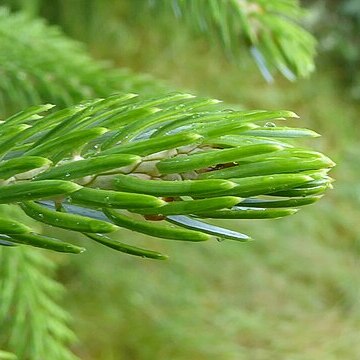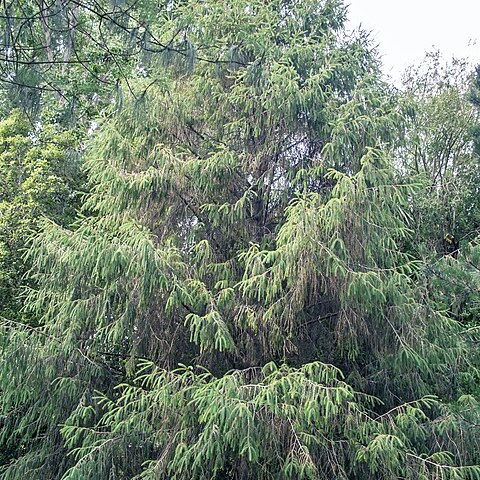Trees to 30 m tall; trunk to 1 m d.b.h.; bark gray or grayish brown, longitudinally fissured into thick, square plates or irregularly flaking; crown conical-pyramidal; branchlets pendulous, initially pale yellow or brownish yellow, turning brownish yellow or brown in 2nd or 3rd year, finally gray; winter buds often ovoid or ovoid-conical, rarely conical at apex, scales appressed at base of branchlets. Leaves directed forward and closely appressed on upper side of branchlets, spreading and almost pectinately arranged on lower side, linear, not parallel sided, slightly curved or straight, flattened, 1-2.2(-2.5) cm × 1-1.5 mm, slightly keeled on both sides, stomatal lines 5-7 in each of 2 white or pale bands adaxially, apex acute or mucronate. Seed cones green, red-or purple-brown, maturing dull brown or brown tinged purplish, ovoid-or cylindric-oblong, 6-10(-12) × 3-4 cm. Seed scales at middle of cones obovate-oblong or rhombic, 1.4-2.2 × 1.1-1.3 cm, base cuneate, distal margin usually recurved, sometimes elongate. Seeds ca. 1.2 cm including wing. Pollination Apr-May, seed maturity Sep-Oct.
More
A tree. It grows to 30 m tall. The trunk is 1 m across. The bark is grey. It is cracked along its length into thick square plates. The crown is cone shaped. The branches hang down. They change form yellow to brown with maturity. The leaves are directed forward and pressed together in the upper side. They are spreading under the branches. They can be slightly curved or straight and flattened. They are 1-2.2 cm long by 1-1.5 mm wide. They are keeled on both sides. The seed cones are green, red or purple brown. They are 6-10 cm long by 3-4 cm wide. The seeds are about 1.2 cm wide.
Can be grown by cuttings or seedlings. Seeds needs stratification.



